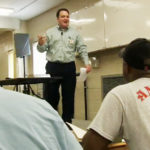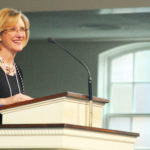Whether Baptists admit it or not, power is both implicit and explicit in our churches, which have borrowed hierarchical structure from the corporate world. But lately, I’ve been hearing about a new form of organization, holacracy, which seems more adaptable to Baptist principles, such as the priesthood of all believers and church autonomy. What do you think?
Holacracy, a business model developed in the last decade by Brian Robertson, may help some churches address issues such as power and participation. Holacracy proposes to flatten the decision-making hierarchy of organizations by replacing management by individuals in a hierarchical arrangement with management by teams called circles.
Circles are given a great deal of autonomy to organize themselves and resolve issues in order to accomplish their tasks. A more complete description can be found by clicking here or in a book, Holacracy: The New Management System for a Rapidly Changing World.
Increase of trust
Proponents of holacracy claim the model increases trust in organizations. Authority is distributed not through a micro-managing boss but through teams regulated by a written statement—called the constitution—which states clearly the rules, processes and expectations for an organization. Every person in an organization is governed by this constitution. Holacracy does not remove the hierarchy but transfers it to teams and not individuals.
Using circles may increase the number of people in a congregation who participate in the church’s work. Those who comprise a circle are considered equals. The circle as a team assigns tasks. The focus in the circle is to accomplish necessary tasks, not analyze what is needed. Each circle selects a person to join another circle of links to other circles, which coordinates the work of the organization.
Circle meetings
Tensions and conflicts are addressed in the governing circle meetings. Predetermined procedures and face-to-face meetings are intended to resolve conflicts. Procedures are set for how to address conflict. Procedures focus on tasks rather than personalities. The structure also encourages resolution before difficulties increase in intensity.
Tensions may simply reflect questions and concerns about whose work is being accomplished as much as difference of opinion and approach. Meetings are held to offer guidance, hold each other accountable and coordinate the work. A church with committees functioning at their best resembles circles in a holacratic organization.
Sign up for our weekly edition and get all our headlines in your inbox on Thursdays
Another value of the circles is the organization may be better able to use one’s gifts or skills. A group with regular meetings can organize and change its assignments when adjustments need to be made. Assignments should be based solely on one’s gifts and abilities.
Not a panacea
Using holacracy as a model may benefit a church, but it is not a panacea. More important than following any business model is following Jesus’ example of servant-leadership. The power that can transform a person and a world comes from serving others rather than from one’s position in a hierarchy.
When James and John sought positions of authority and power, Jesus reminded them they would need to suffer in the same manner as he would. Those who would be first would be those who serve others. Submitting ourselves to one another as Jesus’ disciples will enhance the work of the church. A business model is helpful. A biblical foundation of servant-leadership and mutual submission is essential.
David Morgan, pastor
Trinity Baptist Church
Harker Heights
If you have a comment about this column or wish to ask a question for a future column, contact Bill Tillman, consulting ethicist for “Right or Wrong?” at [email protected].














We seek to connect God’s story and God’s people around the world. To learn more about God’s story, click here.
Send comments and feedback to Eric Black, our editor. For comments to be published, please specify “letter to the editor.” Maximum length for publication is 300 words.